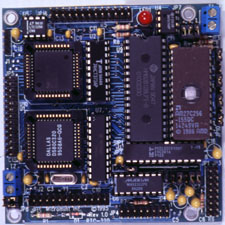


Top Product Lines

ARM Cortex-M SBCs
Our Bambino, Lincoln and Eagle product lines take advantage of the high efficiency and low cost of the ARM Cortex-M microcontrollers by NXP and Texas Instruments. Starting below $25 in single quantities, these controllers are a great choice for data loggers, process controllers, smart instruments and many other applications.
| Bambino 210 (New!) | Eagle 50 |
| Bambino 200 | Eagle 100 |
| Lincoln 60 | picoJTAG |

ARM Linux SBCs
Our Electrum product line is based on the the ARM9 with Debian Linux. With a 400 MHz Atmel AT91SAM9G20 and starting below $100 in single quantities, the Electrum offers unparalleled price/performance for applications that require reliable multitasking and extensive networking functionality.
| Electrum 100 |
| Electrum 200 |

Domino Modules
Our highly popular Domino modules are used in thousands of installations worldwide. Programmable in BASIC and with the most popular I/O interfaces, you can get your embedded application up and running very quickly!
| Modules | RTC Boards |
| Components | BCC Boards |
Micromint USA
 One of Micromint's hottest-selling products for the past five years has been the RTC31/52 stackable controller. It has been a leading price/performance choice among our customers. With our new RTC320 and RTC52-Plus boards, we have expanded the value of that relationship even more.
One of Micromint's hottest-selling products for the past five years has been the RTC31/52 stackable controller. It has been a leading price/performance choice among our customers. With our new RTC320 and RTC52-Plus boards, we have expanded the value of that relationship even more.Occupying the same small 3.5" x 3.5" RTC footprint and 5-V-only power, the RTC320 uses the new Dallas Semiconductor 80C320, which is 8031 code-compatible and 35 times faster. At 33 MHz, the RTC320 is an 8-MIPS controller! Along with the new powerful processor, the RTC320 board accommodates up to 192 KB of memory, 2 serial ports (RS-232 and RS-485), 24 bits of TTL parallel I/O, and a 2-channel 12-bit ADC. The RTC320 puts some real firepower under the abundant variety of RTC I/O expansion boards. Plugging in your favorite ICE or EPROM emulator is the easiest way to develop code. For the diehards who like to twiddle the bits directly, we have a ROM monitor specifically designed for the Dallas '320.
| Processor: | Dallas 80C320 | Clock speed: | 11/22/33 MHz | |
| Max Memory: | 192 KB | SRAM/EPROM: | 110 KB/64 KB | |
| Digital I/O: | 24 bits, PIA | Serial Ports: | 2 (RS-232 & RS-232/-485) | |
| ADC (sample rate): | 05 V, 2 chan., 12 bits (11.1k) | Timers: | 3 | |
| External Interrupts: | 2 | Real-time Clock: | Yes, SmartWatch socket (opt.) | |
| Size: | 3.5" x 3.5" | Power (fully loaded): | +5 V 33 MHz: 250 mA; 11 MHz: 125 mA |
|
| Dev. Software: | Optional | ROM Monitor: | Yes |
This email address is being protected from spambots. You need JavaScript enabled to view it. or Call for Pricing






